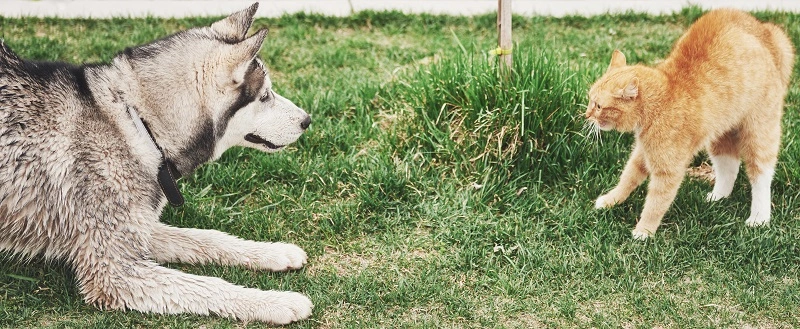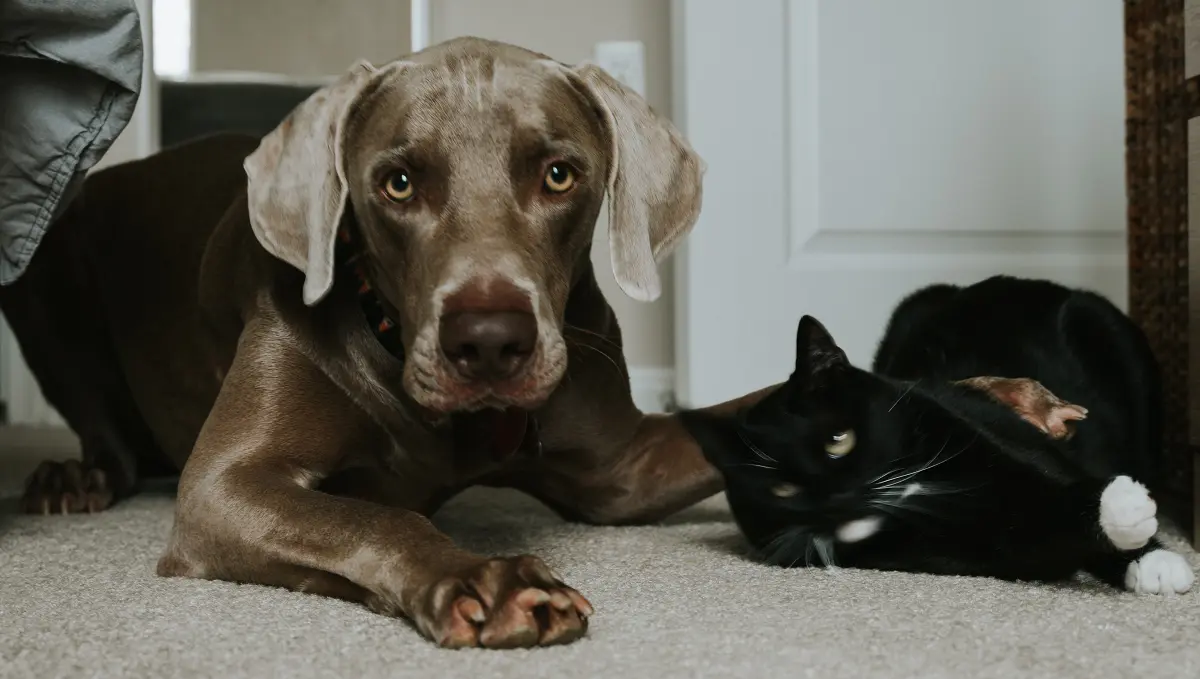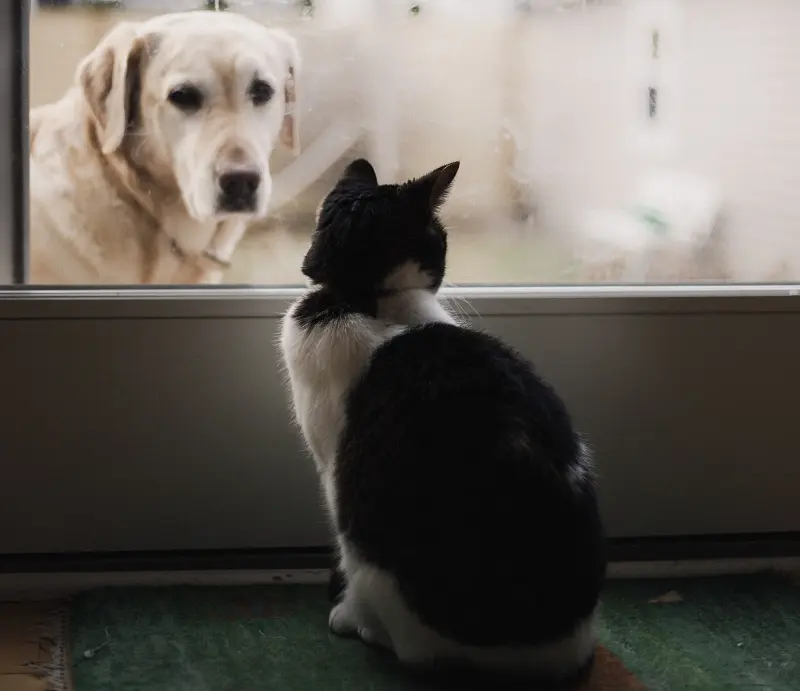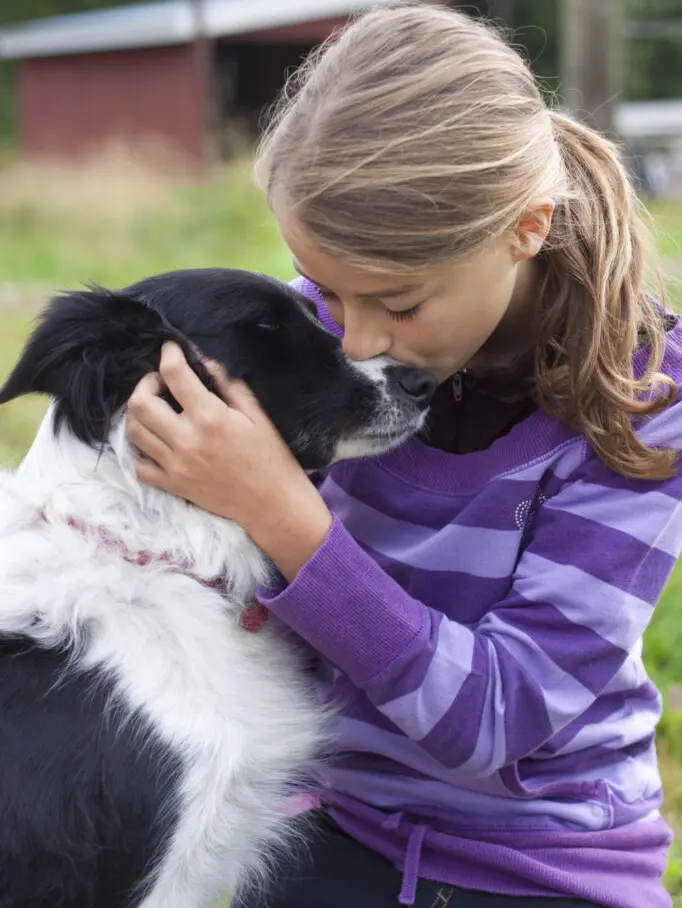How To Stop Dog Aggression Towards Cats: 5 Realistic Solutions
Cats and dogs are stereotyped to be mortal enemies. However, the truth is that dogs aren’t really born to become adversaries with felines. Knowing how to stop dog aggression towards cats starts from puppyhood and the moment you introduce the kitty. It’s important to identify the root of aggression and introduce your dog to the cat properly. Socialization, training, and using calming aids will also be a big help. As pet parents, it’s our responsibility to ensure that both our dogs and cats will get along. In this post, I discuss the signs of dog aggression and what you can do about it.
Signs that your dog is cat aggressive


Sometimes, it can be tricky to determine whether your dog is rough playing with the cat or showing aggression. The following signs should help you point out aggressive tendencies:
- Nipping and biting the cat. It’s not normal for dogs to hurt cats. If it happens during playtime, you must watch out as it can progress into play aggression.
- Avoiding the cat. If your dog moves abruptly when the cat approaches, it’s a sign that the former doesn’t welcome the presence of the feline. It can be a precursor to aggressive behavior.
- Resource guarding. Dogs guard that snarl and bark when the cat approaches their toys exhibit what is called resource guarding. It’s an aggressive behavior because the dog sees the cat as a threat to his belongings. Knowing how to stop dog possessive aggression is important here.
Ways to stop your dog’s cat aggression

While some dogs are born with strong predatory aggression, there’s a workaround to help them get along with a cat. Just remember that you can’t erase your dog’s instincts. Still, you can do the following to help ease the animal’s aggressive behavior.
1. Determine the cause of aggression
Before you do anything, it’s important to know the reason behind your dog’s aggression toward cats. Identifying the root of the problem will help you take the necessary steps.
Most of the time, cat-aggressive dogs are the dominant ones. Canines live in packs where the hierarchy is established. If your dog is used to being the alpha, they may perceive the presence of an imposing cat as a challenge to their position.
However, you should also consider the possibility that your dog had a traumatic experience with cats before. When a cat is present, the canine may try to defend himself through aggressive actions.
If you own both the cat and the dog, the aggression might be due to attention-seeking. Your dog probably feels left out as you give more attention and petting to the cat.
Also, a male dog may become aggressive toward a male cat, though this is a rare occurrence. Feline aggression can also be a culprit here, especially if you have multiple cats at home.
2. Desensitize your dog
One of the most important methods in stopping your dog’s cat aggressive nature is desensitization. With this, you will train your dog to change its view of cats. This is a long process, especially for canines with a strong prey drive.
Use positive reinforcement, so your dog will associate cats with rewards. For example, if a cat is around your aggressive canine, call your dog’s name to stop its barking and snarling. When it does stop the aggressive behavior, give it a treat right away. Please read here do shih tzus bark a lot
Also, it will help to introduce cats slowly to your dog. Ask a friend to hold a leashed cat from a distance. Let your leashed dog see it and watch over its reaction. If it barks or exhibits aggressive tendencies, say ‘stop’ or call its name. When your dog stops the aggressive reaction, give it a treat right away.
Over time, you can bring your dog closer to the cat until it’s no longer reacting aggressively. Remember to take it slowly and keep desensitization sessions short. This should help solve the territorial aggression of your dog.
3. Focus on socialization and training
To make your dog less aggressive toward cats and other people, early socialization is necessary. You must expose your dog to various stimuli, so it won’t feel threatened or scared when around cats. This is a guaranteed way to curb fear aggression at an early age.
If you still have a puppy, it’s a good idea to bring them outdoors. This will let the doggo sniff around. You can also try leaving a cat’s used toy to let your pet get used to the new scent. As your dog gets familiar with the cat’s scent, you can now introduce the kitty. please read here what does it mean when a dog licks a cat
Aside from that, you should train your dog as early as possible. Start with basic obedience, so you’ll have better control of your dog. This is also a good way on how to stop dog aggression towards children, especially infants as they can be victims of redirected aggression.
4. Give both pets their own space
Cats and dogs often get toe to toe because their territories overlap. This makes your dog aggressive toward cats and vice versa.
At home, it’s important to give both pets their own private space. I suggest setting up the individual nests on opposing sides of the house to prevent aggressive encounters due to territorial behavior. Cats are territorial beings, so if a dog tries to invade their space, the feline will defend it. In turn, your dog may perceive the behavior as a threat. It will lead to aggressive behavior if not addressed early on.
It’s important not to let the dog and cat share toys and feeding bowls. This will prevent resource guarding and tension between the two animals. An aggressive cat can also lead to an equally aggressive dog, so this is something to keep in mind.
5. Consider using CBD products
Can CBD help dog aggression? A few studies found that CBD oil can help in addressing a dog’s aggressive behavior. It’s a good way on how to stop dog aggression towards owner and cats. CBD products do this by interacting with a canine’s CB1 and CB2 receptors. The result is a calming effect.
Many pet owners have tried using CBD oil or hemp oil for their pets. But to ensure that it’s suitable for your dog, it’s important to consult the veterinarian first. This will help you understand the benefits and potential side effects, especially if your dog has underlying health problems.
Pet CBD products are available in tincture or soft chews versions. This makes it easy to administer and without second-guessing about the dosage. Just make sure that the product is made specifically for canines.
Take note that CBD products should be paired with proper training and socialization. This will boost its effects and help form a permanent solution.
How long does it take for CBD oil to calm a dog?

It depends on the dosage and CBD product you’re using. For the most part, orally administered CBD products will start working within 10 minutes.
Some may take as long as 30 minutes, depending on how your dog’s body will react to it.
To ensure that the CBD product will work for your aggressive dog, you must regularly communicate with the vet. This will also curb adverse side effects.
What happens if I give my dog too much CBD?
A cat-aggressive dog that consumed too much CBD will experience vomiting, diarrhea, and poor appetite. Ataxia or lack of muscle control can also occur if the canine consumed large doses in one sitting. Please read here: How To Clean Up Dog Vomit from Carpet & Hardwood
If you are to use CBD products to calm your aggressive dog, you must be careful with the dosage. Consulting the vet will prevent overdosage from happening.
Conclusion
Knowing how to stop dog aggression towards cats is a multi-faceted task. You have to identify the main cause and act upon it. Remember that proper socialization, training, and positive reinforcement are the most effective solutions here. You can also pair it with CBD products for the best results.
